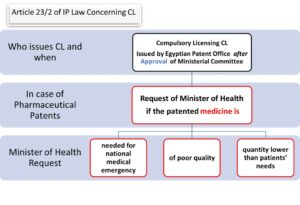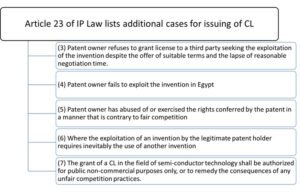Ibrachy & Dermarkar | View firm profile
Introduction
There has been some recent interest from the GOE in certain aspects of the Compulsory Licensing (CL). They are beginning to explore it inter alia, in the pharmaceutical industry.
CL is a balance of interest provision found in the TRIPS (Trade-Related Aspects of Intellectual Property Rights) Agreement. It balances between the exclusivity right of the innovator and the interests of a country to use the protected patent without compromising the financial interests of the innovator. It is available to the WTO members and is stipulated in the Article 31 of the TRIPS (1).
The Egyptian legislator included CL in the Law on the Protection of Intellectual Property No. 82 of 2002 (2). Articles 23 and 24 of the IP Law dealt with the compulsory licensing system for patents in terms of the justifications, conditions, and procedures for granting compulsory licensing. According to Article 23 of the IP Law, procedures for granting CL of patented products require the approval of a Ministerial Committee formed by a decision of the Prime Minister. It is worth noting that, since the law was issued in 2002 and until today, no compulsory licenses have been issued.
In early February 2020, the Prime Minister issued a decree forming the Ministerial Committee stipulated in Article 23 of the Law .
CL Regime
The Egyptian CL regime is an administrative regime subject to revision of the Administrative Court. Its provisions are articles 23 & 24 of IP law No. 82/2002, the executive regulation of IP law articles No. 36 -43 (4). The Prime Minster Decree No. 251/2020 (3) formed the Ministerial Committee that shall examine the requests and issue CL approval. Issuing the CL itself is the responsibility of the Egyptian Patent Office (EPO) according to article (23) of the Egyptian IP Law.
Article 23/1 of the IP Law can be outlined as follows:

Requesting of Compulsory Licensing of a certain pharmaceutical product by the Minister of Health due to an urgent medical situation:
According to article 23/2, special CL shall be issued by the EPO as follows

Other Cases Explained in Article 23:
EPO may subject to the approval the Ministerial Committee grant CL for the exploitation of an invention. The committee decides the financial rights of the patent owner when such CLs are issued, in any of the following cases outlined below:

Outline of CL Steps
Use of the CL shall be limited to the applicant; EPO may however grant it to a third party.
Outlines of the CL steps in light of the Egyptian IP Law are as follows:
- A secretariat, within the EPO which is established, by a decision/decree issued by the Chairman of the Academy for Scientific Research and Technology) is responsible for receiving the CL application. This application shall be filed on the CL form and registered by the mentioned secretariat thereof in a special registry record where the applications shall be listed according to the date of their presentation to the EPO. Then the secretariat shall prepare the applications to be examined by the EPO.
- The applicant (for example a pharmaceutical generic company in event of pharmaceutical preparations patents) submits the CL application to the EPO on a form containing the following details:
- The name of the applicant company and its legal form JSC, Inc, LLC etc.
- The number of the patent, the name of the patent and the number of the patent application and the date of its filing.
- The form shall include the field/sort of the patent.
- The remaining period of the protection.
- The proposed royalty or compensation for obtaining the CL.
- Alongside with the CL application, the applicant shall introduce evidence proving that it has exerted, within a reasonable period, all the required diligent efforts to obtain a voluntary license from the patent owner.

So, the following documentation should be included to support the applicant’s request to be granted a CL:
-
- The documentations evidencing that the CL applicant has the industrial capabilities to exploit the patent.
- The documentation evidencing the CL applicant has diligently negotiated consensual license for a reasonable period. and the patentee has refused the proposals.
- Evidence that the patentee has refused the proposals of the CL applicant despite the voluntary license proposal was based on FRAND terms, fair, reasonable, and non-discriminatory terms.
- The EPO examines the CL application and its annexes. Also, in case the EPO considers such CL application satisfies the requirements that the applicant has exerted, within a reasonable period, all the required efforts to obtain a voluntary license from the patent owner, the EPO would accept the CL application along with preparing a supportive memorandum.
- The CL file annexed with EPO’s opinion/memorandum it accepts the Cl application shall be then referred to the Ministerial Committee.
The Ministerial Committee was established by a decision/decree from the Prime Minister under number 251 /2020 and published on 29 January 2020. This decision/decree includes the members of the Ministerial Committee and the competences thereof. The members are as follows: the Minister Of The Higher Education, the Minister Of Supply and the Internal Trade, the Minister of Health, the Minister Of Trade and Industry, and the Head of The Competition Authority.
- The Ministerial Committee examines the CL application, annexed documentation and the opinion of the EPO, to examine whether or not the requirements thereof are satisfied.
- In event of the acceptance/approval of the Ministerial Committee to grant a CL, the EPO shall issue the CL decision granting the applicant (for example a generic company) thereof. This means that the EPO is the final authority to issue the decision granting the CL based on the approval of the Ministerial Committee to grant such CL.
- On the compensation matter, the competent authority is a committee formed by a decision issued by the Chairman of the Academy of Scientific Research and Technology to determine the fair compensation of the patent owner in consideration of the exploitation of the patent based on several factors mentioned in Article (41) of the Executive Regulations. These factors are the remaining protection period of the patent, the volume and the value of production, the proportion of the price of the patented product to the average per capita general income, the scale of investment required for researches for the commercial launch, the availability of a similar product in the market. Damages caused by arbitrary or anti-competitive practices of the patentee.
- However, the determination of such committee of the fair compensation shall be presented and approved by the Ministerial Committee of CL and this committee shall issue its decision determination of the compensation in parallel of issuing the decision of the CL.
- The patent owner shall be notified by the EPO with the decisions of granting the CL and the determination of the fair compensation by a registered letter with acknowledgment of receipt.
- The patent owner may petition against the CL decision or against the estimation of the compensation. The petition shall be filed before the Petition Committee within thirty days from the dated of notification to the patent owner with the CL decision. This committee is headed by a judge from The Court of Appeals. The committee includes also a Judge from the State Council, in addition to three technical members. This committee is already formed, and it examines the petitions against the decisions of EPO. It also examines, for example, the appeals against the refusal of granting a patent. This Petition Committee shall convene meetings with the concerning parties and might refer the petition to an expert or to a committee of Experts. However, the decision of this committee is appealable before the Administrative Court at the State Council within 60 days from the date of the notification with its decision.
- On the associated timeline, and in actual situation, it is difficult to stand on an accurate timeline or anticipated timeline because of the lack of any precedents in CL.
Relevant Authorities
- The Academy of Scientific Research and Technology, EPO, the Ministerial Committee, the Petitions Committee within EPO, and the Administrative Court.
A secretariat within the EPO, shall receive the CL request application on a specific form and prepare the applications to be examined by the EPO. - The EPO examines the CL application to make sure that the requirements of CL are met.
- The EPO would accept the CL, then EPO prepares a memorandum with its opinion. The opinion contains the two elements, the first, the reasons of why the CL application shall be accepted, and the second, what the estimated royalties/ the fair compensation that shall be paid by the would-be licensee. This estimation shall be determined by a specialized committee set up by the president of the Academy of Scientific Research and Technology. The estimation of the compensation shall be based on several factors mentioned in Article (41) of the Executive Regulations.
- The EPO refers to the CL application request and its annexes and the EPO memo to the Ministerial Committee.
- The Ministerial Committee examines the CL application and makes sure that the requirements are satisfied.
- based on the approval of the Ministerial Committee to grant such CL, the EPO shall issue the CL decision granting it to the applicant.
- The EPO shall notify the patentee with the CL decision immediately through a registered letter with acknowledgment of receipt.
- This CL decision is challengeable within a statutory period of 30 days by the patentee before the petition Committee within the EPO. This committee shall decide on the petition within 60 days. However, these 60 days are merely indicative and not mandatory. The petitions committee might exceed this timeline while examining the petition.
- The patent applicant might choose not to wait until the petition committee decides on the petition, instead, the applicant might choose one of the two paths:
- File a challenge before the Administrative Court in the State Council directly, provided that the statement of the appeal incorporates a request of staying the enforceability of the challenged decision, or,
- Filing a petition before the Petition Committee and waiting for the lapse of 60 days mentioned in Article 36 of the Egyptian IP law without receiving a response from the Committee. The failure of the Committee to respond within 60 days gives the applicant the right to file an appeal before the Administrative Court to challenge the EPO decisions.
- The decisions of the Petitions Committee are subject to judicial review before the Administrative Court within (60) sixty days as of the date of notifying the concerned party thereof with a registered letter with an acknowledgment of receipt.
References:
- “TRIPS Agreement (as amended on 23 January 2017)”. org.
- Egyptian Law on the Protection of Intellectual Property No. 82 of 2002
- Prime Minster decree No. 251/2020
- The executive regulation of IP law